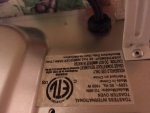Yeah, if 11 A is fine on the circuit, then in the absence of any other info, that gives you a lower limit on the total current you can run on that circuit, and you can say with near certainty that plugging in multiple appliances that add up to 11 A will also be OK.
As you pointed out, you do have additional info though, since the current limit that trips each breaker is printed on it.
Just to add more interesting math/factoids to this discussion, the relationship that power = voltage*current (P = IV) is exactly true for DC, where you have a steady flow of charge across a steady voltage drop (drop in potential energy per charge) and hence you have a steady power dissipation (rate of potential energy drop with time).
But of course, household electricity runs on AC, where the driving voltage, and hence the current, is not steady in one direction. It's a sine wave. So the charges aren't flowing through the circuit in one constant direction, they're oscillating back and forth. So why is it still okay to use P = IV with the voltage, current, or power numbers printed on household devices? Well, those numbers aren't the peak of the sine wave. I.e. the voltage in household electricity doesn't oscillate between +120 V and -120 V as the sine wave moves up and down. 120 V is the RMS (root mean square) of the voltage values over one period of the oscillation. Why is this used? Well consider a device that is purely resistive, meaning charges flow through it and lose energy, heating up the device (like the filament in a toaster oven). For a device like this, the oscillating voltage and current will always be in phase, which means they will change in lockstep with each other. So you're always dissipating energy, but the amount varies depending on when you look. At the instant that the voltage (and current) is at its peak, you're dissipating a lot of energy, whereas at the instant that the voltage and current are at 0 in their oscillation, you're not using any energy at all. You need some way of expressing the average energy dissipation i.e. the average power. For things that vary around 0, root mean square (the square root of the mean of the square of all the individual values) is a natural way to do so. For a sine wave, the RMS over one period of oscillation is equal to root(2) of the peak of the oscillation. So the voltage actually oscillates between +120*root(2) = +169.7 V and -120*root(2) = -169.7 V. You can show that if you multiply the RMS voltage times the RMS current, it gives you the average power dissipation over one oscillation period. But I won't show that here, because it requires calculus. So, the conclusion is, for AC power, provided you are using RMS voltages and currents, you can treat them as DC, and use P = IV...
...or can you? Like I said, for a purely resistive "load" (where load is electrical engineering jargon for the device that is drawing energy from the circuit), current and voltage are always in phase. But all real circuits, in addition to resistance, have things called inductance and capacitance. I'll use inductance as an example...it's a name for a lag that is introduced that prevents you from instantaneously accelerating charges around (in violation of conservation of energy). This lag/delays physically manifests as a magnetic field that gets set up due to the current, and has to change when you change the current, but changes slowly, introducing inertia to the system. Loads that have coils of wire that set up very strong magnetic fields (e.g. the windings of the motor in your washing machine) have a very high inductance. The result is that the current and voltage end up no longer being in phase i.e. they don't vary in lockstep, but there is a significant time lag between their sine waves. Sometimes the current is going up even though the voltage is going down, or vice versa. What this means is that sometimes the charges are moving through the circuit in the opposite direction from the direction that the voltage wants to drive them in. So, at those times, the charges actually gain potential energy, rather than losing it! You can physically interpret this as energy that was stored up in the magnetic field of the inductor being released and supplying power back to the source. But of course it goes back and forth, being released and then drawn back in, over and over again. So this is power that doesn't do any real work in terms of watts dissipated, e.g. to heat things up or put things into motion. It's just shuffled into and out of the magnetic field over and over again. But it is power that still determines how much current-carrying capacity your circuit needs and hence what gauge of wire/conductor you need. You can still use P = IV in this type of AC situation, only now I and V have to be complex numbers, rather than real numbers. The real part of P is the actual power dissipated, and electrical engineers measure it in watts, the imaginary part, which is called reactive power, is the part that's being shuffled into and out of inductive (or capacitive) loads and otherwise not doing anything, and electrical engineers measure that in a unit they made up "volt-amps reactive", which is numerically the same as a watt, but is given a different name in order to distinguish the reactive power from the real power. The total, which is a vector sum of the real part and imaginary part, in the complex plane, is called "apparent power" and is measured in "volt-amps." The apparent power is what you always end up with when you multiply the RMS voltage and current together. For a non-inductive or non-capacitive load, it's equal to the real power.
I thought I would give this crash course on AC power, since it brings in a lot of interesting math, including complex numbers, and the OP said they were interested in real world applications of math/physics.




